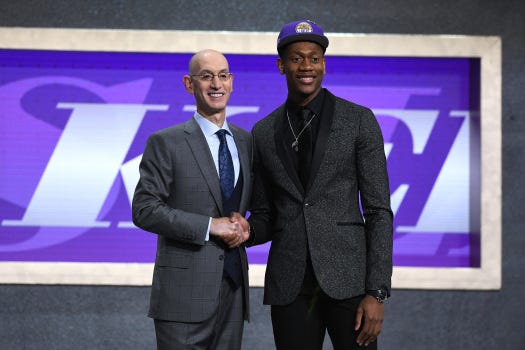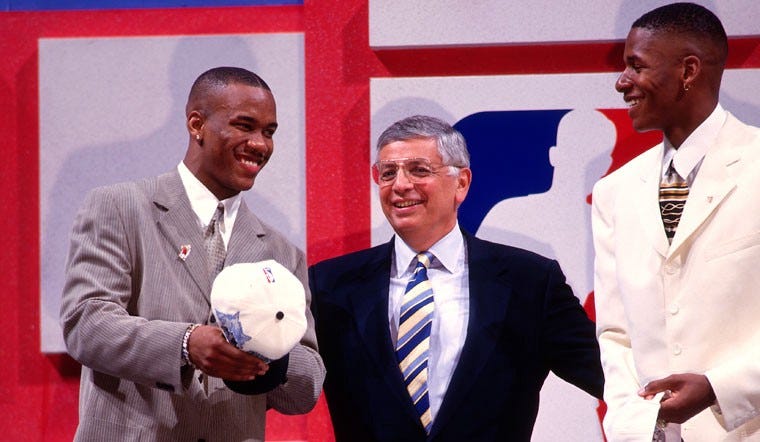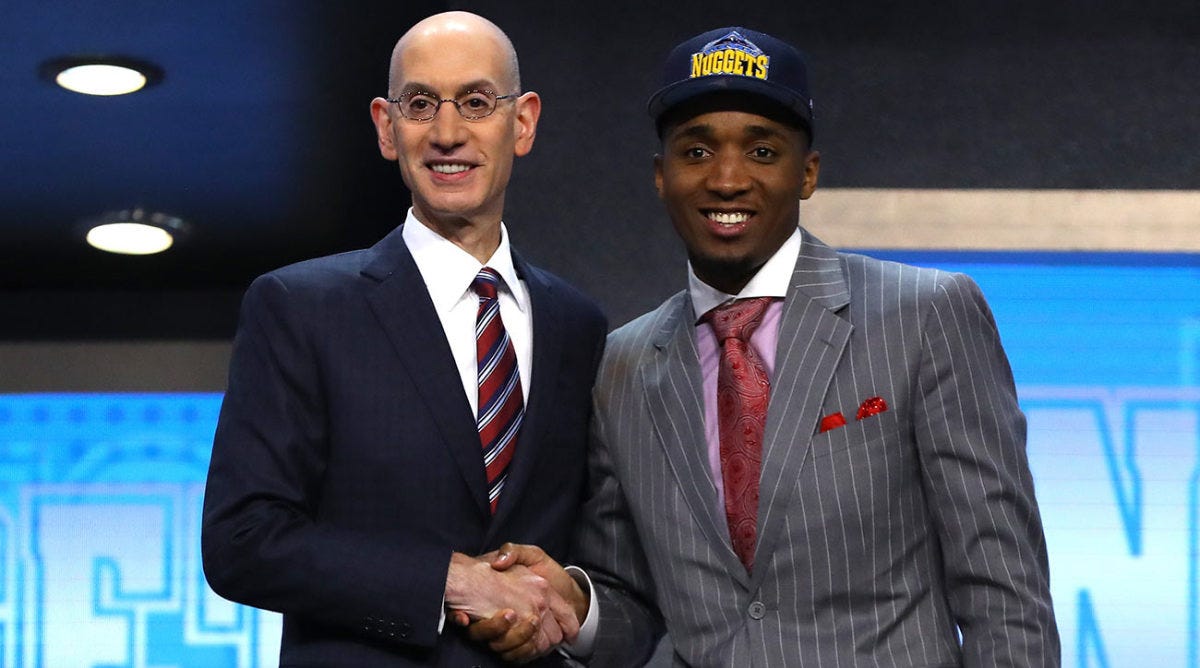STICK TO TEASERS
Hey y’all, I’m working on something big and fun for next week, and I’m excited about how it’s coming along. But yes, I’m Saving it for later, so I’ll Throw you blessed friends ~3,000 words about the NBA Draft to tide you over for a bit.
STICK TO SPORTS
Draft Day trades! The hallowed tradition of the NBA where David Stern and Adam Silver take pictures with extremely tall young men wearing hats of teams they’ll never play for.
What was your favorite moment of the De’Andre Hunter Lakers era? (Photo by Sarah Stier/Getty Images)
Usually, the selections themselves are negotiated as trade terms in advance; in essence, you see a team select a player that it wouldn’t have taken for itself. It’s just that NBA labor rules dictate that the picks be made prior to the trade being finalized, as opposed to the real-time trade announcements you see in the NBA. So when Milwaukee drafted Stephon Marbury and Minnesota took Ray Allen in consecutive picks in 1996, they were essentially drafting for each other.
Hat swap! Photo via Slam Magazine
That being said, every now and then there’s a deal that backfires or otherwise alters the NBA landscape. Here’s a few I’ve been thinking about recently.
2006: Chicago Trades LaMarcus Aldridge
Damn right we’re jumping straight into GarPax territory. The 2005-06 Bulls were a perfectly average 41-41 team, but with a lot of young players including Luol Deng, Ben Gordon and Tyson Chandler all 23 years or younger. Kirk Hinrich and Andres Nocioni, at 25 and 26, were the elder statesmen of the rotation. The potential was there, but the post scoring was limited to the likes of Mike Sweetney and Othella Harrington. Thanks to a disastrous trade by the Knicks (shocker, right?) to pick up Eddy Curry, the Bulls owned the 2nd overall pick of the 2006 Draft, and fans’ prayers were answered when Chicago took the far-and-away best post scorer in the mix, PF LaMarcus Aldridge out of the University of Texas.
Bonus points to Aldridge for bringing a UT hat for Stern to wear. Image via Texas Athletics
GarPax being GarPax, of course, Chicago then got googly eyes at #4 pick Tyrus Thomas, a super-bouncy PF from LSU whose skill set could charitably be described as “in need of further development.” Chicago improved to 49-33 the next season, but with Thomas only logging 11 minutes a game and not a serious member of the rotation, which was now featuring 37-year-old P.J. Brown and very-expensive free agent Ben Wallace (whose rebounding and blocks had been diminishing for years) in a pair of post-draft deals. Tyson Chandler, we hardly knew ye.
The Bulls were easily dispatched in the Eastern Conference semis by Detroit, whose frontcourt rotation of Rasheed Wallace, Chris Webber (remember?) and Antonio McDyess feasted on Chicago’s mix of age and limitations. The series went six games, but it was never, ever in doubt.
Aldridge, meanwhile, played 22 minutes a game and even started 22 games in his rookie campaign for the Trailb Lazers (weird name but whatever), and he was an everyday starter averaging 17 ppg by the next season. He’s now a 7-time All-Star on the cusp of 35,000 career minutes played, and he recently crept past 50% on the Hall of Fame probability calculator.
The what if on this one is pretty simple: what if Chicago never trades that pick? The team was nearly ready to start competing, really competing in the East (remember, LeBron James didn’t start his NBA Finals streak until 2011), and the horrific decision to trade Chandler for Brown and J.R. Smith (soon flipped for Howard Eisley and two future 2nd-round picks, YIKES) doesn’t need to be made anymore.
In fairness, you can sort of see what GarPax liked.
It was widely known at the time that Aldridge was readier for the NBA than Thomas, and with Aldridge and Chandler in the frontcourt, Chicago could have used the $16m/year it spent on Wallace* to, say, lure an experienced combo big man like Nenê out of Denver (he ended up re-signing there for 6/$60m) and use the leftover money for backcourt depth.
Anyway That’s a starting lineup of Hinrich, Gordon, Deng, Nenê, and Chandler with Chris Duhon, Andres Nocioni and LaMarcus Aldridge first off the bench in 2006-07, and Aldridge cementing his starting role shortly thereafter. That lineup causes serious trouble for most teams in the East, and maybe, just maybe, there’s a deep postseason run or two in there.
*Instead, Wallace was on his way out of town by the next season’s trade deadline, and the incoming Drew Gooden and Larry Hughes both didn’t last a full season in Chicago. It’s almost like GarPax actively made this team worse, over and over!
2017: Denver Trades Donovan Mitchell
This is almost certainly one of the instances where a pick is made on behalf of the other team; Denver had no need for Mitchell when he was drafted, and he was traded for PF rotation pieces Trey Lyles and Tyler Lydon, marking quite possibly the first time someone’s been traded for two players next to each other in the alphabetical list of all NBA players.
You’re out of your element, Donny. Mike Stobe/Getty Images
This was an understandable move at the time for the Nuggets; Lydon obviously didn’t do much with his career, but Lyles was young and worth taking a shot on, while Denver’s backcourt was already fully set with Gary Harris and Jamal Murray looking like the core of the future along with Nikola “Serbian Totoro” Jokic in the frontcourt.
Mitchell, of course, was exactly what the Jazz needed in their backcourt, averaging 20 points per game en route to an All-Rookie selection, and he’s now the undisputed leader of the 26-6 Jazz, comfortably the best record in the West this season. Utah rolled double-sixes with this trade/pick, and Mitchell looks like he could end up really high on the career scoring list if he can stay healthy.
It would have been silly for Denver to draft and keep Mitchell; he would have added very little to Harris and Murray in the backcourt. But what if Denver traded Gary Harris instead?
Harris had thus far played above his draft slot and was a mere 23 years old at the time, but was still often struggling on defense and had already shown signs of persistent injury trouble that continue to this day. Also, Murray was the obvious future star of that backcourt, scoring 10 ppg in just 21 minutes per game as a 19-year-old rookie. 21-year-old Jokic was also averaging a 17-10-5 and clearly ready to do more.
Now, obviously if Denver’s scouts believed Mitchell was an instant star in his own right, the front office never would have traded his rights for Lyles and Lydon. But if they had, Harris could have been moved for a better package than that — energetic combo forward Trevor Booker, for example, ended up being traded by Brooklyn about a month into the ensuing season. Include whatever spare parts you need on either side to make it work.
If Denver had a dynamic backcourt like Murray and Mitchell alongside Jokic and Paul Millsap and the Nuggets’ coterie of serviceable wings, it’s wholly possible that it’s Denver, not Utah, who’s the 1 seed in the West this season. Also, with two elite scorers in the backcourt, that Nuggets-Lakers bubble series probably goes very differently. Hmmmmmm.
Sharing is caring. It’s in the Bible, READ IT.
1996: Charlotte Trades Kobe Bryant
If you don’t want to read about Kobe Bryant, I understand. Feel free to skip ahead.
Also, this trade happened two weeks after the trade. I’m breaking all my own rules.
By now, the trade is the stuff of NBA legend: Jerry West sends Vlade Divac to Charlotte in exchange for Lower Merion high school star and soon-to-be second-generation NBA player Kobe Bryant, who ends up having a legendary run with the Los Angeles Lakers, including five rings and a mythic presence in even the most diehard Laker fans’ minds. Bryant never met a shot he didn’t like, and he had the talent to make them all, and his competitive streak mirrored that of his fellow swaggering shooting guard, Bob Sura. Wait, I’m told I mean Michael Jordan. Whoever that is.
The question isn’t what if Charlotte keeps Kobe Bryant, because that probably wouldn’t have worked out great for the Hornets. Glen Rice and David Wesley were in their primes and already filling Kobe’s role for Charlotte, plus there’s no way he would have been happy in the middle of the Carolinas, not an ardent student of the game like him. Kobe in teal? Nah.
The Boston Celtics revealed years later that they were enamored with Bryant during the 1996 draft process, but since it was widely regarded as a “big six” draft at the time and the C’s had worked their way into the six, that pick of Antoine Walker would have paid off, and it kinda did! Walker was an instant starter and heavy contributor to Boston’s attack, averaging over 20 ppg for the Celtics (!), but, like… it’s Boston. It’s the 1996 draft. You want to end up with more than Shimmying Kevin Gamble.
Bryant couldn’t have gone at #6 in that draft. That’s an alternate universe that looks way too much like hindsight. It’s not that Boston drafted Walker at #6, it’s what happened between there and Bryant’s eventual selection at #13 by the Hornets, only to be dealt by Charlotte to the Lakers for better-than-you-remember center Vlade Divac. You know what happened from there.
The question is: what if Boston had traded for Bryant before Jerry West and the Lakers did?
Again, Vlade Divac was really, really good. A zero-time All-Star when LA shipped him off to Charlotte for Kobe, yes, but he was still in his mid-20s and establishing himself as a vanguard of the 21st century NBA and all its ball movement.
Which is to say, was that a daring amount of talent to give up for high schooler Kobe Bean Bryant? Yeah, it was.
But could Boston have matched that kind of trade capital on draft day or in the ensuing weeks? Absolutely. Dino Radja was a similarly talented and productive big man, although the Celts didn’t have the kind of depth there that the Lakers enjoyed, but Dana Barros and Rick Fox were also there begging to be trade chips for a singular talent like Bryant.
And make no mistake, Boston knew exactly how singular Bryant could be. From a 2015 ESPN article, Bryant’s predraft workout and interview floored the Celtics’ front office brass:
The 6-foot-6 Bryant had wowed the Celtics in his predraft workout, awed them in a sit-down interview that Carr said was the best he had ever seen.
Auerbach had seen footage. He saw the glowing report compiled by the team's scouting director, Rick Weitzman, who declared, "There was nothing the kid couldn't do."
[…]
"I tell you, he put on a shooting exhibition the way he stroked the ball," Carr remembers. "It was unbelievable. We put him in a lot of catch-and-shoot situations. We put him in dribble across the middle, pull-up-and-shoot. We let him stroke a little bit from the 3-point line. But it was a lot of quick release, get-it-off-quick [shots] to see if he could do that, because we knew at the next level, he was going to have to get it quick against better defenses than in high school.
"But he did it in flying colors."
Bryant's session reminded the Celtics of another high-flying guard.
"If you closed your eyes and thought a little bit, you might have thought you were watching Michael Jordan," says then-Celtics general manager Jan Volk. "He did everything well -- beyond well. He was exceptional in everything that he did. And then we commented, as I recall, on how reminiscent he was of Michael."
Siri, show me an alternate universe. Tom Landers/The Boston Globe/Getty Images
The 1996 draft had a “Super Six,” and Boston was happy to trade up from #9 to #6 to get Antoine Walker. And even though the draft also ended up with crazy depth — 23 draftees ended up with careers of 10 seasons or longer — you can’t tell me Golden State would have turned down Dino Radja for that 12th pick because the tantalizing talent of Vitaly Potapenko was too much to pass up.
And yeah, Kobe wasn’t an All-Star — or even a starter — from Day 1. He was a kid. And high school players hadn’t been established as reliable, to say the least. And that’s ultimately what pushed Boston to move into the top six:
[Boston scouting director Rick Weitzman] adds, "I told the higher-ups that the kid was a tremendous talent, [had] tremendous potential, outstanding approach to the game, but he probably wouldn't be ready to contribute to an NBA team for a couple years, which ultimately proved pretty accurate.
"We couldn't afford to wait, unfortunately."
With the game-ready Walker in tow, Boston immediately went from a 33-win team… to a 15-win team, still the worst performance in franchise history. Coach/GM M.L. Carr was unceremoniously dumped thereafter for Rick Pitino, starting that whole era of sadness in Beantown, which included trading 3rd-overall pick Chauncey Billups midway through his rookie season.
So yes, in a slightly different universe, by 1998, Boston could have had a starting lineup of Chauncey Billups, Kobe Bryant, Paul Pierce, Antoine Walker and Tony Battie. Have fun thinking about that, C’s fans! If you want to swear at me, here’s a handy button to do just that.
2013: Nobody Trades With Toronto
The 2013 draft was notable for two things: Anthony Bennett going first overall, despite not being especially good at basketball; and Giannis Antetokounmpo going to Milwaukee with the 15th pick, revitalizing the Bucks franchise.
In 2020, the Raptors released footage from that draft showing brand-new GM Masai Ujiri, freshly plucked from the same role in Denver, setting his sights on that lanky teen from Greece:
As mentioned in the video, the Raptors (correctly) believed that while Giannis was two years away from realizing his potential, by the time he did he’d be better than anyone in the 2015 draft class. Karl-Anthony Towns ended up being the obvious gem of the 2015 draft, but other than that, they were right; there’s as many misses as hits in the lottery picks.
Ironically, Toronto would have been in perfect position to draft Antetokounmpo; after a 34-48 season, the Raptors were slotted with the 12th pick. Unfortunately, previous GM Bryan Colangelo had traded that pick the year before… for Kyle Lowry. OK, Toronto’s probably fine with that now.
By 2015, Toronto was in control of the NBA Atlantic Division, and with a backcourt of Kyle Lowry and DeMar DeRozan cemented in the starting lineup, Giannis would have likely developed into a pick-and-roll terror and spot point guard, alongside his now-legendary defensive prowess and transition skills. And maybe, just maybe, the Raps would have been better-prepared for that three-year stretch where they were fed to LeBron and the Cavs in the playoffs.
If there’s any regret on Antetokounmpo’s part about ending up in Milwaukee, he hasn’t shown it; he’s re-signed twice with the Bucks, including a 5-year, $228-million supermax extension signed in December 2020 amid several advances from other teams — including the Raptors (oh, you thought it was a coincidence they released that seven-year-old footage when they did?).
So we know Toronto would have been a nightmare on both ends of the court if Ujiri makes that trade. But imagine how ugly this scenario becomes for Milwaukee. The Bucks built a new arena in 2018, one that ownership has said was necessary for the team to stay in Milwaukee. It took a great deal of effort for owners to cajole the state legislature to spend $250 million on the construction of the arena (I have thoughts about that, to say the least, but whatever), and “we have Giannis” was certainly part of that pitch. Fiserv Forum is colloquially known as “the house that Giannis built,” and if he’s not there to build it, we might be looking at the Las Vegas Bucks (money! gambling!) or the Seattle Supersonics 2.0 today.
Wait oh no — I’m sorry if any of you are old Seattle fans. I didn’t mean to do this to you.
You can’t stay mad at me, so go ahead and subscribe.
STICK TO AFFIRMATIONS
Thanks for joining me today. We'll always end on a kind word.
Think of the best moments of your life. I hope you’ve got a lot of them, or I hope there’s a lot yet to come for you. Think about who celebrated your best days with you, and how good it made you feel to celebrate with them. Take that same joy to your relationships with as many people around you as possible — I promise it’ll enrich your life just as much as your own accomplishments.
If you’d like, tell me in the comments about something good for you.










This space you're carving out here, Adam, is good.
I'll start with something obvious, warm spring days are rather good.